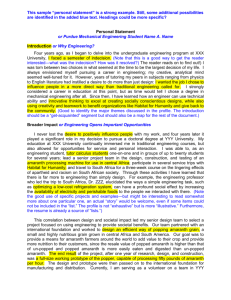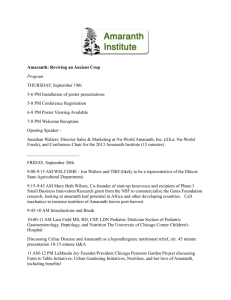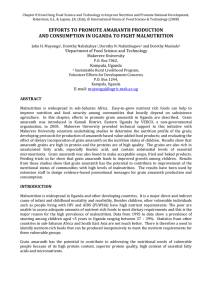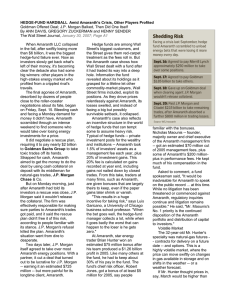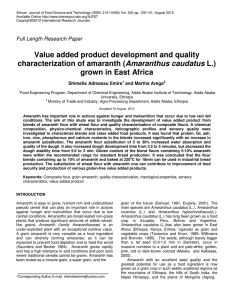AllAfrica.com, Washington 03-27-07 Uganda: Grain Amaranth - a Hope for Nutrition Problems
advertisement
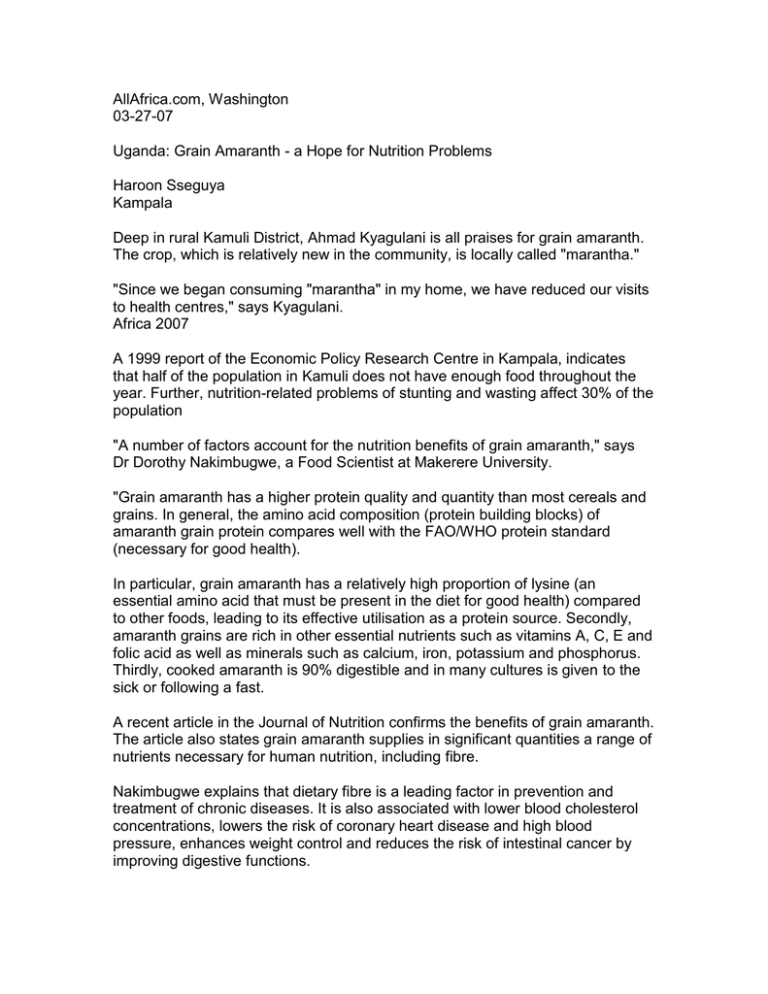
AllAfrica.com, Washington 03-27-07 Uganda: Grain Amaranth - a Hope for Nutrition Problems Haroon Sseguya Kampala Deep in rural Kamuli District, Ahmad Kyagulani is all praises for grain amaranth. The crop, which is relatively new in the community, is locally called "marantha." "Since we began consuming "marantha" in my home, we have reduced our visits to health centres," says Kyagulani. Africa 2007 A 1999 report of the Economic Policy Research Centre in Kampala, indicates that half of the population in Kamuli does not have enough food throughout the year. Further, nutrition-related problems of stunting and wasting affect 30% of the population "A number of factors account for the nutrition benefits of grain amaranth," says Dr Dorothy Nakimbugwe, a Food Scientist at Makerere University. "Grain amaranth has a higher protein quality and quantity than most cereals and grains. In general, the amino acid composition (protein building blocks) of amaranth grain protein compares well with the FAO/WHO protein standard (necessary for good health). In particular, grain amaranth has a relatively high proportion of lysine (an essential amino acid that must be present in the diet for good health) compared to other foods, leading to its effective utilisation as a protein source. Secondly, amaranth grains are rich in other essential nutrients such as vitamins A, C, E and folic acid as well as minerals such as calcium, iron, potassium and phosphorus. Thirdly, cooked amaranth is 90% digestible and in many cultures is given to the sick or following a fast. A recent article in the Journal of Nutrition confirms the benefits of grain amaranth. The article also states grain amaranth supplies in significant quantities a range of nutrients necessary for human nutrition, including fibre. Nakimbugwe explains that dietary fibre is a leading factor in prevention and treatment of chronic diseases. It is also associated with lower blood cholesterol concentrations, lowers the risk of coronary heart disease and high blood pressure, enhances weight control and reduces the risk of intestinal cancer by improving digestive functions. Nakimbugwe cautions: "It should, however, be noted that although it is a nutrient rich grain, amaranth is best used as a supplement to other foods because on its own, it cannot sustain the nutrition requirements for good health." Maintaining adequate supplies is also hard, therefore, other foods whose supply can be assured throughout the year need to be used in conjunction with grain amaranth. Grain amaranth was introduced in Kamuli in 2005 through the efforts of a local non-governmental organisation, Volunteer Efforts for Development Concerns (VEDCO), which implements a food and nutrition security programme in the area. It is one of the food items suited for achieving quick results in combating the food insecurity and malnutrition problems. "In a community of 4,000 households, 1000 are currently producing amaranth," says Grace Babirye, VEDCO's field team leader in Kamuli. "We started supplying grain amaranth to community members in September 2005. We have had no problems of pests, diseases or taste. The farmers really like this crop and are yearning for more." Grain amaranth is native to Central America. There are currently 60 varieties of the crop being grown in different parts of the world - Africa, Asia and Central America. Dr David Brenner, the amaranth curator at Iowa State University, notes: "Despite its advantages, sustained adoption of grain amaranth has been upset by agronomic and processing challenges. Food, Agriculture and Rural Issues "The small size of grains poses challenges for machine planting and harvesting. National and international research efforts have also sidelined it as a marginal crop, compared to others like corn, which evolved from Central America. However, interest in the crop has been rekindled, especially in developing countries," he observes. Kyagulani hopes that more farmers in the community access grain amaranth seed and training on production and processing of the crop. "My wish is that VEDCO expands its activities and support to more households. It will greatly transform our nutrition status. It may be a good source of income in future. We currently produce for subsistence, though some farmers from Iganga are selling to some supermarkets in Kampala," he observes.

